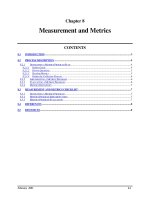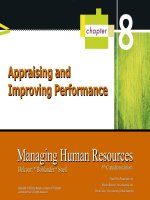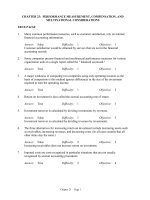Chapter 8 progress and performance measurement and evaluation
Bạn đang xem bản rút gọn của tài liệu. Xem và tải ngay bản đầy đủ của tài liệu tại đây (4.32 MB, 43 trang )
Source: Mc Graw Hill Education. All Rights Reserved, 2021
CHAPTER 8:
PROGRESS & PERFORMANCE
MEASUREMENT & EVALUATION
© 2021 McGraw-Hill Education. All rights reserved. Authorized only for instructor use in the classroom.
No reproduction or further distribution permitted without the prior written consent of McGraw-Hill Education.
2
Project Monitoring System for Control
• Information System Structure
– What data are collected?
• Current status of project (schedule & cost)
• Remaining cost to compete project
• Date that project will be complete
• Potential problems to be addressed now
• Out-of-control activities requiring intervention
• Cost and/or schedule overruns & the reasons for them
• Forecast of overruns at time of project completion
3
Project Monitoring System… (cont’d)
• Information System Structure (cont’d)
– Collecting data & analysis
• Who will collect project data?
• How will data be collected?
• When will the data be collected?
• Who will compile and analyze the data?
– Reports & reporting
• Who will receive the reports?
• How will the reports be transmitted?
• When will the reports be distributed?
4
Project Progress Report Format
• Progress since last report
• Current status of project
– Schedule
– Cost
– Scope
• Cumulative trends
• Problems and issues since last report
– Actions and resolution of earlier problems
– New variances and problems identified
• Corrective action planned
5
The Project Control Process
• Control
– The process of comparing actual performance against
plan to identify deviations, evaluate courses of action,
and take appropriate corrective action.
• Project Control Steps
1. Setting a baseline plan.
2. Measuring progress and performance.
3. Comparing plan against actual.
4. Taking actions
6
Monitoring Time Performance
• Tools used to catch negative variances from plan
and communicate project schedule status:
– Tracking and baseline Gantt charts
• Show expected, actual, and trend data for event duration
performance.
– Control charts
• Plot the difference in scheduled time on the critical path with the
actual point on the critical path.
7
Baseline and
Tracking Gantt
Charts
FIGURE 13.1
8
Project Schedule Control Chart
FIGURE 13.2
9
Disparity Among Monitoring Systems
• Time-Phase Baseline Plan
–Corrects the failure of most monitoring systems to connect
a project’s actual performance to its schedule and forecast
budget.
• Systems that measure only cost variances do not identify resource
and project cost problems associated with falling behind or
progressing ahead of schedule.
• Earned Value Cost/Schedule System
–An integrated project management system based on the
earned value concept that uses a time-phased budget
baseline to compare actual and planned schedule and
costs.
10
Glossary of Terms
• EV
– The percent complete times its original budget. The percent of the
original budget that has been earned by actual work completed. The
older acronym for this value was BCWP—budgeted cost of the work
performed.
• PV (Planned Value)
– The time-phased baseline of the value of the work scheduled. An
approved cost estimate of the resources scheduled in a time-phased
cumulative baseline (BCWS—budgeted cost of the work scheduled).
• AC
– The actual cost of the work completed. The sum of the costs incurred in
accomplishing work. (ACWP—actual cost of the work performed).
TABLE 13.1
11
Glossary of Terms
• CV
– Cost variance is the difference between the earned value and the actual
costs for the work completed to date where CV=EV-AC.
• SV
– Schedule variance (SV) is the difference between the earned value and
the baseline line to date where SV=EV-PV.
• BAC
– Budgeted cost at completion. The total budgeted cost of the baseline or
project cost accounts.
• EAC
– Estimated costs at completion. Includes costs to-date plus revised
estimated costs for the work remaining.
TABLE 13.1
12
Glossary of Terms
• ETC
– Estimate to complete.
• VAC
– Cost variance at completion (BAC-EACe), where EACe is derived by
estimators in the field.
– Or, alternatively, cost variance at completion (BAC-EACf), where EACf
is derived from a formula using actual and earned value costs.
– VAC indicates expected actual over-or underrun cost at completion.
TABLE 13.1
13
Developing an Integrated Cost/Schedule System
1. Define the work using a WBS.
a. Scope
b. Work packages
c. Deliverables
d. Organization units
e. Resources
f. Budgets
2. Develop work and resource schedules.
a. Schedule resource to activities
b. Time-phase work packages into a network
3. Develop a time-phased budget using work packages
included in an activity.
14
Developing an Integrated Cost/Schedule System
1. Define the work using a WBS.
a. Scope
b. Work packages
c. Deliverables
d. Organization units
e. Resources
f. Budgets
2. Develop work and resource
schedules.
a. Schedule resources to activities
b. Time-phase work packages into
a network
3. Develop a time-phased
budget using work packages
included in an activity.
Accumulate budgets (PV).
4. At the work package level,
collect the actual costs for
the work performed (AC).
5. Multiply percent complete
times original budget (EV).`
6. Compute the schedule
variance (EV-PV) and the
cost variance (EV-AC).
15
Project Management System Overview
16
FIGURE 13.3
Development of Project Baselines
• Purposes of a Baseline (PV)
–An anchor point for measuring performance
• A planned cost and expected schedule against which actual cost and
schedule are measured.
• A basis for cash flows and awarding progress payments.
• A summation of time-phased budgets (cost accounts as summed
work packages) along a project timeline.
• What Costs Are Included in Baselines?
–
–
–
–
Labor
Equipment
Materials
Project direct overhead costs (DOC)
17
Baseline Data Relationships
FIGURE 13.4
18
Development of Project Baselines (cont’d)
• Rules for Placing Costs in Baselines
– Costs are placed exactly as they are expected to be
“earned” in order to track them to their point of origin.
– Percent Complete Rule
• Costs are periodically assigned to a baseline as units of work are
completed over the duration of a work package.
19
Methods of Variance Analysis
• Comparing Earned Value
–With the expected schedule value.
–With the actual costs.
• Assessing Status of a Project
– Required data elements
• Data Budgeted cost of the work scheduled (PV)
• Budgeted cost of the work completed (EV)
• Actual cost of the work completed (AC)
– Calculate schedule and cost variances
• A positive variance indicates a desirable condition, while a negative
variance suggests problems or changes that have taken place.
20
Methods of Variance Analysis
• Cost Variance (CV)
–Indicates if the work accomplished using labor and
materials costs more or less than was planned at any point
in the project.
• Schedule Variance (SV)
–Presents an overall assessment in dollar terms of the
progress of all work packages in the project scheduled to
date.
21
Cost/Schedule Graph
FIGURE 13.5
22
Earned Value Review Exercise
FIGURE 13.6
23
Developing A Status Report:
A Hypothetical Example
• Assumptions
– Each cost account has only one work package, and each cost
account will be represented as an activity on the network.
– The project network early start times will serve as the basis for
assigning the baseline values.
– Baseline value will be assigned linearly, unless stated differently.
– From the moment work on an activity begins, some actual costs will
be incurred each period until the activity is completed.
24
Work Breakdown Structure and Cost Accounts
FIGURE 13.7
25









